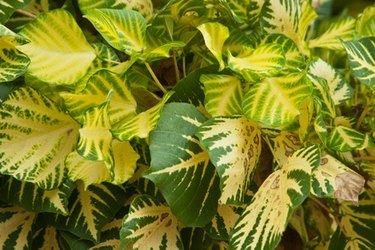Things You'll Need
Houseplant fertilizer
Potting soil

Ficus trees are widely grown office and house plants because they are easy to care for and adapt to the less than optimal conditions found in most houses and public buildings. Numerous varieties have been developed by growers for the houseplant trade including variegated forms of Ficus benjamina, the weeping fig, and F. elastica, the rubber plant. Weeping figs have white-to-cream variegation on light green leaves, while rubber plants have cream, white, yellow or red streaking on dark green leaves.
Step 1

Select a location for the variegated ficus tree. The location should be bright with indirect light such as a west facing window or a lightly shaded southern exposure. Be sure to keep the tree away from cold drafts which will cause sudden leaf drop.
Video of the Day
Step 2
Water variegated ficus trees when the soil has begun to dry dry slightly. To test the soil, stick your finger 1 to 2 inches below the surface. If it is wet, wait to water, if it is dry add water until it runs out of the bottom of the pot.
Step 3
Fertilize variegated ficus trees when they are actively producing new growth in the spring and summer months when the days are longer. Mix a balanced liquid houseplant fertilizer to half strength and add it to the water once a month. Stop fertilizing as the days get short in the fall and winter.
Step 4
Repot variegated ficus trees every two to three years. In optimal conditions, the trees can get large and may need to be transferred to a container that is a few inches larger in diameter than the old one. Always use fresh potting soil and sterilized flower pots to prevent disease transmission. Commercial mixes work well for ficus trees.
Step 5
Prune ficus trees with sharp scissors or pruning shears as they start to get too tall. Cut just above a leaf or where a leaf used to be and new growth will form from the node. Regular trimming will help maintain a full bushy shaped tree. Pruning can be done at any time, but the tree will recover faster while it is actively growing in the spring and summer.
Tip
Plant tall trees in heavy pots such as terracotta or ceramic so they do not fall over easily.
Warning
Ficus trees do not like to be moved and may respond to any changes in temperature, light or watering schedule by dropping all of their leaves. Under healthy growing conditions, the leaves should grow back in a few weeks. Ficus roots do not like to be water logged and will rot if the soil remains too wet. Avoid touching the white sap that leaks from wounds on the leaves and branches. It can be a skin irritant for some people.
Video of the Day